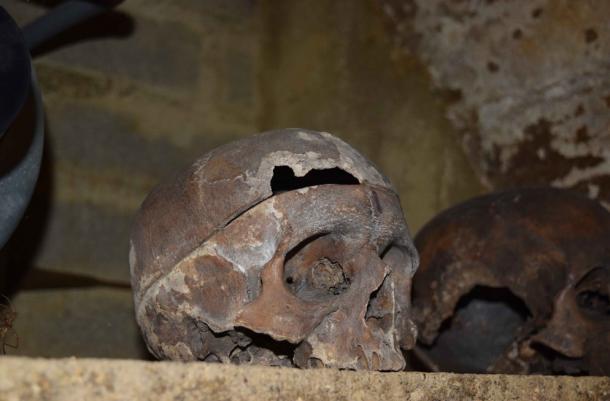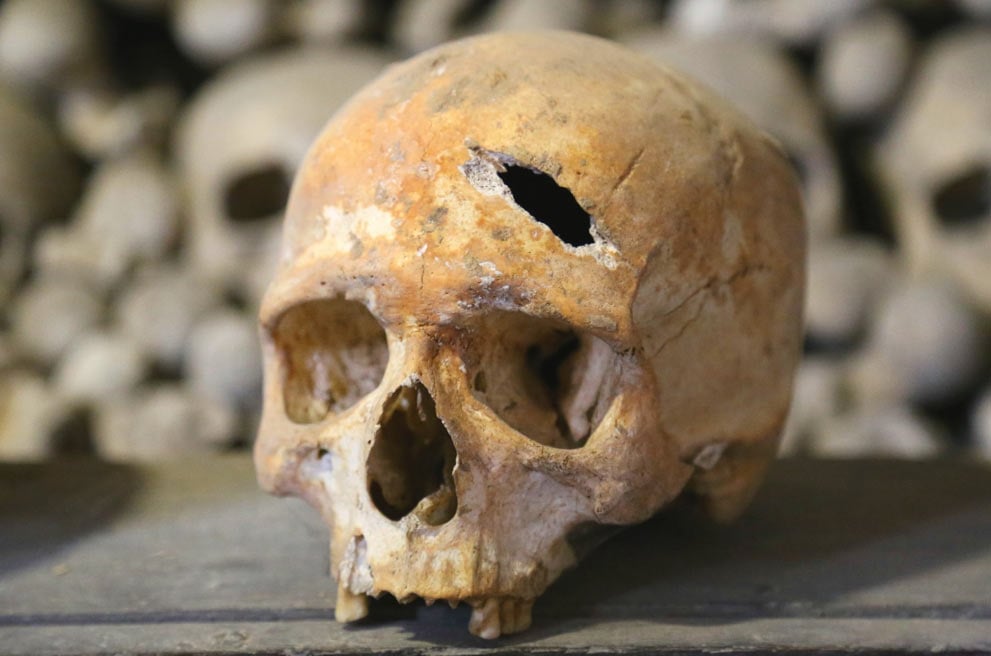Medieval Skull Found Beneath Rothwell Church Shows Violent Blow
In a dark crypt that lies beneath an active parish church in England, the remains of thousands of men, women and children who died in medieval Britain are stuffed into crates and stacked on wooden racks from floor to ceiling. Experts have begun examining some of the skulls one-by-one and a violent history is beginning to emerge, with one of the first medieval skulls to be examined showing signs of death by forceful blow to the head.
The BBC reports that archaeologists selected five skulls out of the remains of around 2,500 people that lie in the underground chapel beneath Holy Trinity Church in Rothwell, Northamptonshire, and one showed a fracture caused by a violent blow.

A view inside Charnel House, Rothwell, showing stacks of bones. Credit: The Rothwell Charnel Chapel Project / University of Sheffield.
Hidden Hall of Bones
The hidden hall of bones containing thousands of dead was a secret kept for centuries. Local legend says in the 1700s, a grave digger, at his work, swung his pick. The ground gave way and he tumbled headlong into a dark chamber, to be met with a horrifying sight: white, grinning skulls and piles of skeletal remains in every direction. He had inadvertently discovered the long-forgotten charnel house beneath Holy Trinity Church in Rothwell.
According to The Guardian, the charnel house – or bone store – at Rothwell, dating to the 13th century is of international importance. Last year, the interior of the charnel house was scanned and recreated digitally by scientists and archaeologists of the University of Sheffield.
Archaeologist and leader of the Sheffield University research project, Dr Lizzy Craig-Atkins told The Guardian at the time: “Rothwell charnel chapel is a site of major international significance. Surviving charnel chapels, with human remains still housed inside, are very rare in England. What is so fascinating about the Rothwell charnel chapel is that it presents an ideal archaeological resource for researchers to use to advance our understanding of how the remains of the dead were treated during the medieval period.”
Medieval Skulls and Bones
The charnel house is unique as it’s believed to be one of only two medieval charnel houses in England which still holds their original human remains in situ.
Charnel houses or ossuaries are vaults or underground chambers, usually built near churches, to store the overflow of bones after they’ve been dug up from cemeteries when burial space is scarce. The newly dead will be buried in graveyards, and then later dug up and interred in the charnel house. The bones can get mixed up and it’s not clear who is who at the other end of history. Identifying bodies and matching skulls to bones is a challenge for archaeologists.
Dr Craig-Atkins told the BBC that charnel houses were "deliberately built so people could be prayed for. They were built to be visited"
While the charnel house was sealed up and apparently forgotten, it was reportedly intended to be visited by the living as the chapel was at one time lit by two windows, and one of the walls sported a panting of the Resurrection.
- The Eerie Bone Church of 40,000 Souls
- Old skeletons, possibly plague victims, found under Paris grocery
- Would You Visit Five Centuries of Bones? The Scary Spanish Ossuary of Wamba
History of Rothwell – From Vikings to Saxons
The town of Rothwell is believed to have once been a Viking settlement called Rodewell (the place of the Red Well) in the 9 th century.
Rothwell has an annual proclamation where the granting of the original Town Charter by King John in 1204 is celebrated.
The church’s earliest foundations date back to the 12th century and were erected on an earlier Saxon site. This early Norman church survives in the chancel, but numerous restorations and renovations have occurred since then.

Church of the Holy Trinity Rothwell parish church is dedicated to the Holy Trinity and is on the site of an Anglo Saxon predecessor. The current church was built in the medieval period. Largely restored or rebuilt 1873, it is a grade II listed building (CC by SA 2.0).
Whose Remains?
Early theories about the bones at the Holy Trinity Church, which have since been disproved and put to rest by historians and researchers, include that they belonged to: Danes slain in battle by the Saxons, men slain at Naseby Battlefield 1645 (eight miles away) or at Bosworth Battlefield 1485 (thirty miles away), or victims of a plague epidemic.

One of the skulls from the Charnel House in Rothwell which shows multiple fractures, as well as evidence of anatomization, likely from an autopsy. Credit: The Rothwell Charnel Chapel Project / University of Sheffield.
"We picked it out to try to redress some of the stories... suggesting when you find a lot of skeletal remains it is because there has been some sort of massacre," Dr Craig-Atkins told the BBC.
"But the fact there was only one in the study who suffered violence shows... there is a representative selection of bones you would find from any medieval community."
And of course, violence was fairly commonplace in medieval Britain!
Still, only a tiny proportion of the 2,500 remains have been examined and further research on the men, women and children that lie there may shed more light on their individual stories.
Top image: Human skull showing blow to the head (Perthsnap / Adobe Stock). Representational image only, not the actual skull found in Rothwell.

















